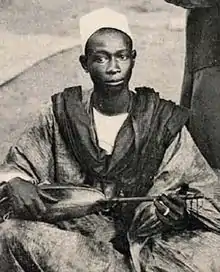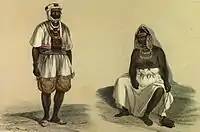Nyamakala
The Nyamakala, or Nyamakalaw, are the historic occupational castes among Islamic societies of West Africa, particularly among the Mandinka people.[1][2] The Nyamakala are known as Nyaxamalo among the Soninke people,[1][3] and Nyenyo among the Wolof people.[4] They are found throughout the Sahel region, from Mali and Senegal to Chad and several other parts of the West African region historically known as the "Western Sudan".[5]

The term Nyamakala originally implied any talented people, but as slavery, social differentiation and stratification increased with Islamic religious violence called jihads, and later the colonial rule, their status fell to a lowly level below the nobles and free people.[1] Nyama in the traditional Mandinka society implies "vital force", while Kala connotes "handle". Thus, any type of occupation that handled vital force of nature, were a Nyamakala.[1] In its historic contexts, state Charles Bird, Martha Kendall and Kalilou Tera, Nyama has implied different meanings. In one, it connotes notions of "evil or satanic force, dangerous, polluting, energizing, imperfect self control" and in others it is "morally neutral or energizing". In yet another context, Nyama implies "refuse, garbage".[6] With the arrival of Muslims, the evil or polluting contexts became their focus, while the caste people themselves preferred the neutral or energizing connotations.[7]
Among Mandinka, the Nyamakala occupational castes included Jeli or Jeliyu (musicians, griots), Numu (carpenters, smiths), Garanke (leather workers, weavers) and Fune or Finah (singers specializing in Islamic praise).[1] The specific castes had different terms in other ethnic groups of West Africa. For example, among the Soninke people, the griots were called Gesere, the smiths Tage and the carpenter caste was called Sake.[1]


The Nyamakala have been endogamous, occupation inheriting castes.[8][9][10] Among the Mande people such as the Mandinke, Soninke and others, Nyamakala caste people have been despised and considered of lowly status, in some regions as Jon (slave) and Wolosa (descendant of slave).[11][12]
Some scholars such as Vaughn state that while Nyamakala have been castes of West Africa, it necessarily does not mean imply a generic and uniform "caste system" because the social stratification in Africa was very complex with the inclusion of slaves, race and religious elements.[13][14] Others consider Nyamakala as a part of a caste system, while acknowledging that there were regional variations.[15][16][17]
See also
References
- Leslie M Alexander; Walter C. Rucker Jr. (2010). Encyclopedia of African American History. ABC-CLIO. pp. 79–80. ISBN 978-1-85109-774-6.
- Anthony Appiah; Henry Louis Gates (2010). Encyclopedia of Africa. Oxford University Press. p. 532. ISBN 978-0-19-533770-9.
- Tamari, Tal (1991). "The Development of Caste Systems in West Africa". The Journal of African History. Cambridge University Press (CUP). 32 (2): 221–250. doi:10.1017/s0021853700025718. S2CID 162509491.
- Charles Bird; Martha Kendall; Kalilou Tera (1995). David C. Conrad and Barbara E. Frank (ed.). Status and Identity in West Africa: Nyamakalaw of Mande. Indiana University Press. p. 37. ISBN 978-0253209290.
- Mamby Sidibe (1959), "Les gens de caste ou nyamakala au Soudan français." Notes Africaines, Volume 81 (1959), pages 13-17
- Charles Bird; Martha Kendall; Kalilou Tera (1995). David C. Conrad and Barbara E. Frank (ed.). Status and Identity in West Africa: Nyamakalaw of Mande. Indiana University Press. pp. 29–31. ISBN 978-0253209290.
- Charles Bird; Martha Kendall; Kalilou Tera (1995). David C. Conrad and Barbara E. Frank (ed.). Status and Identity in West Africa: Nyamakalaw of Mande. Indiana University Press. pp. 28–29. ISBN 978-0253209290.
- Tamari, Tal (1991). "The Development of Caste Systems in West Africa". The Journal of African History. Cambridge University Press (CUP). 32 (2): 221–223. doi:10.1017/s0021853700025718. S2CID 162509491.
- Melissa Thackway (2003). Africa Shoots Back: Alternative Perspectives in Sub-Saharan Francophone African Film. Indiana University Press. pp. 57 with caption 25. ISBN 0-253-34349-6.
- Keith Cartwright (2015). Reading Africa into American Literature: Epics, Fables, and Gothic Tales. University Press of Kentucky. p. 9. ISBN 978-0-8131-5833-4.
- Charles Bird; Martha Kendall; Kalilou Tera (1995). David C. Conrad and Barbara E. Frank (ed.). Status and Identity in West Africa: Nyamakalaw of Mande. Indiana University Press. pp. 36–38. ISBN 978-0253209290.
- Marchand, Trevor H. J. (2015). "'IT". Africa. Cambridge University Press. 85 (2): 356–364. doi:10.1017/s0001972015000054. S2CID 144653484.
- JH Vaughn (197). "Caste System in the Western Sudan". In Arthur Tuden and Leonard Plotnicov (ed.). Social Stratification in Africa. Free Press. pp. 59–92. ISBN 978-0029327807.
- Marguerite Dupire (1985), A Nomadic Caste: The Fulani Woodcarvers Historical Background and Evolution, Anthropos, Bd. 80, H. 1./3. (1985), pages 85-100
- Christopher L. Miller (1990). Theories of Africans: Francophone Literature and Anthropology in Africa. University of Chicago Press. pp. 78–80. ISBN 978-0-226-52802-1.
- Eugenia W. Herbert (1994). Iron, Gender, and Power: Rituals of Transformation in African Societies. Indiana University Press. pp. 177–180. ISBN 0-253-11596-5.
- Bethwell A. Ogot (1999). Africa from the Sixteenth to the Eighteenth Century. University of California Press. pp. 17–18. ISBN 978-0-520-06700-4.
Bibliography
- David C. Conrad; Barbara E. Frank (1995). Status and Identity in West Africa: Nyamakalaw of Mande. Indiana University Press. ISBN 0-253-11264-8.
- Barbara G. Hoffman (2001). Griots at War: Conflict, Conciliation, and Caste in Mande. Indiana University Press. ISBN 0-253-10893-4.
- Tal Tamari (1991). "The Development of Caste Systems in West Africa". The Journal of African History. Cambridge University Press. 32 (2): 221–250. doi:10.1017/s0021853700025718. JSTOR 182616. S2CID 162509491.
- Todd, David M. (1977). "Caste in Africa?". Africa. Cambridge University Press. 47 (4): 398–412. doi:10.2307/1158345. JSTOR 1158345. S2CID 144428371.
- Eric Charry (2000). Mande Music: Traditional and Modern Music of the Maninka and Mandinka of Western Africa. University of Chicago Press. ISBN 978-0-226-10161-3.
- Karl G. Prasse (1995). The Tuaregs: The Blue People. Museum Tusculanum Press. ISBN 978-87-7289-313-6.